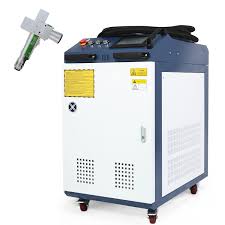The Power of Laser Cleaning Systems
In recent years, laser cleaning systems have emerged as a revolutionary technology in the field of industrial cleaning and surface preparation. Unlike traditional methods that use chemicals, abrasives, or solvents to clean surfaces, laser cleaning offers a non-contact and environmentally friendly solution that is both efficient and precise.
One of the key advantages of laser cleaning systems is their ability to remove contaminants such as rust, paint, grease, and oxides from a variety of materials without damaging the underlying surface. This is achieved through a process known as laser ablation, where the intense energy of the laser beam vaporizes the unwanted material, leaving behind a clean and residue-free surface.
Another benefit of laser cleaning systems is their versatility. They can be used on a wide range of materials including metals, plastics, ceramics, composites, and more. Whether it’s restoring historical artifacts, preparing surfaces for welding or painting, or removing coatings in industrial settings, laser cleaning systems offer a precise and efficient solution for various applications.
Furthermore, laser cleaning systems are environmentally friendly as they eliminate the need for harsh chemicals or abrasive materials that can be harmful to both workers and the environment. By using focused laser beams to clean surfaces, these systems reduce waste generation and contribute to sustainable practices in industrial cleaning processes.
As technology continues to advance, so do laser cleaning systems. Manufacturers are constantly improving the efficiency and capabilities of these systems to meet the evolving needs of industries worldwide. With features such as automation, real-time monitoring, and user-friendly interfaces, laser cleaning systems are becoming an indispensable tool for enhancing productivity and quality in various sectors.
In conclusion, laser cleaning systems represent a significant advancement in industrial cleaning technology. Their ability to provide precise, non-contact cleaning solutions while being environmentally friendly makes them an attractive choice for industries looking to improve efficiency and sustainability in their operations.
Understanding Laser Cleaning Systems: Effectiveness, Comparisons, and Limitations
- Does laser cleaning really work?
- What is the difference between ultrasonic cleaning and laser cleaning?
- What are the disadvantages of laser cleaning machine?
- Is laser cleaning better than sandblasting?
Does laser cleaning really work?
The effectiveness of laser cleaning is a common question among those exploring this innovative technology. Laser cleaning has proven to be a highly efficient and reliable method for removing contaminants from surfaces without causing damage. Through the process of laser ablation, the intense energy of the laser beam vaporizes unwanted materials, leaving behind a clean surface. This non-contact method is particularly effective in removing rust, paint, grease, and oxides from various materials while preserving the integrity of the underlying surface. With its track record of success in diverse applications, laser cleaning has established itself as a trusted and effective solution for industrial cleaning needs.
What is the difference between ultrasonic cleaning and laser cleaning?
When comparing ultrasonic cleaning and laser cleaning, the key difference lies in the mechanisms through which they operate. Ultrasonic cleaning utilizes high-frequency sound waves to create cavitation bubbles in a liquid solution, which then implode to dislodge contaminants from surfaces. In contrast, laser cleaning involves the use of focused laser beams to vaporize unwanted materials directly from the surface without the need for any additional substances. While ultrasonic cleaning is effective for removing dirt and debris from intricate or hard-to-reach areas, laser cleaning offers a non-contact and precise solution that is ideal for delicate surfaces or materials where traditional methods may cause damage. Ultimately, the choice between ultrasonic and laser cleaning depends on the specific requirements of the cleaning task at hand and the type of material being treated.
What are the disadvantages of laser cleaning machine?
When considering laser cleaning machines, it is important to acknowledge some potential disadvantages. One common drawback is the initial cost of acquiring a laser cleaning system, which can be higher compared to traditional cleaning methods. Additionally, the maintenance and servicing of laser cleaning machines may require specialized skills and equipment, adding to the overall operating expenses. Another factor to consider is the safety precautions necessary when operating high-powered lasers, as improper use can pose risks to both equipment and personnel. Despite these challenges, advancements in technology continue to address these concerns, making laser cleaning systems an increasingly viable and efficient option for various industrial applications.
Is laser cleaning better than sandblasting?
When comparing laser cleaning to sandblasting, it’s important to consider the specific requirements of the cleaning task at hand. While sandblasting is a traditional method that effectively removes surface contaminants through abrasive blasting, laser cleaning offers a non-contact and precise alternative. Laser cleaning eliminates the need for abrasive materials, reducing waste generation and environmental impact. Additionally, laser cleaning can be more gentle on delicate surfaces and provides a more controlled cleaning process compared to the potentially harsh effects of sandblasting. Ultimately, the choice between laser cleaning and sandblasting depends on factors such as material sensitivity, desired precision, and environmental considerations.

No Responses